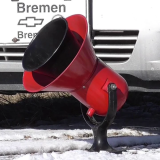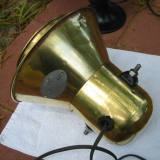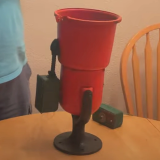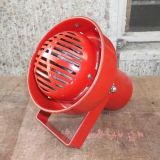Model A
| Federal Signal Model A | |
 A privately owned Federal Sign & Signal-era Model A. | |
| Company | |
|---|---|
| Produced | 1917-present |
| Type | Directional Electromechanical |
| Sound output | 103 dB @ 10 ft |
| Horsepower | ⅓ hp |
| Voltage | 6/12/24/120/240 V AC/DC |
| Documentation | Manual Product sheet |
Model A, formerly Type A, is a small industrial electric siren produced by Federal Signal, and is the oldest siren still produced by the company, as well as one of the oldest siren designs currently still in production. This siren is intended for use in industrial areas, indoor use, and short-range outdoor warnings. The Model A shares this purpose with the heavier duty Model L in Federal Signal's lineup.
History

The Model A was first introduced in 1917 by the Federal Electric Company as the Type A and was released alongside the larger dual rotor Type Mach. B. The Type A was designed for short range use compared to the Type B, able to be mounted on nearly any surface. The siren became popular as an industrial warning siren, as well as a fire siren for rural communities. A heavy-duty alternative of the Model A became available a few years after the Model A was introduced, named the Model J; the Model J is suited for extended continuous use, with a heavier duty motor. The Model A was optionally available with a corrosion-resistant brass housing for marine use, as the salty ocean air would quickly corrode a regular siren.

The design of the Model A itself has changed over the years, with the earliest models using sleeve bearings with external oil sumps attached to the motor cover, and the siren lacked finger guards on the stator ports. This was changed early on to include the finger guards, and the sleeve bearings were replaced with different bearings which resulted in the oil sumps being removed. Between 1918 and 1970, the Model A used a large conical skirt to project the sound from the ports, as well as a smaller conical intake. In 1970, the siren received a redesign, with the intake being enlarged and a flanged outer skirt borrowed from the Model D and Model L replacing the conical skirt. Little has changed since then, with the only major change being the metal tags being switched over to stickers on newer units to save on costs. The tag placement has also varied, originally being mounted on the skirt before being moved to the motor cover, where it remains today.
Due to its small size, the Model A is popular both with industrial sites requiring a small siren, as well as with siren enthusiasts who commonly buy these sirens due to the ease of restoring and operating them. Model As can also be commonly found on drawbridges, warning when the bridge is raising. The Model A has stood the test of time as a reliable, cheap siren that gets the job done wherever it is installed. Its closest competitor is the Sentry F-2, as well as Federal's own Model L.
Design
The Model A is simple in design, being a small single rotor electric siren. The siren uses a small 6-port aluminum rotor and stator, driven by a ⅓ hp universal motor running at 120 V AC/DC. The motor runs at a high rpm, with the siren peaking at 1060 Hz. The stator ports have finger guards included, though early Type A models lacked these guards. By default, the Model A comes with a metal stand which attaches to the motor cover through 2 swivel mounts, which allows the siren to be aimed vertically wherever is required. These mounts are secured by nuts to keep them in place. The stand includes holes for mounting on a wall, floor or ceiling. The Model A utilizes a flanged outer skirt borrowed from the Model D and Model L to project the sound from the ports, as well as a smaller conical intake. Like the Model L, the Model A comes painted red from the factory. The Model A is rated at 103 dB at 100 ft.
Variants
Model JC (Code-A)

The Model JC, originally named the Code-A, is a variant of the Model A that was meant for places that needed special short-range code signals which could give vital information or instructions quickly in an emergency or otherwise. The cone-shaped intake and projector are replaced by a single long rounded projector that also serves as the intake. A solenoid-operated damper inside the projector energizes and opens when the siren is operating, and slams shut when the siren shuts off, instantly cutting off the intake of air into the siren and silencing it. This allows for repeated, quick code blasts that are instantly recognizable over standard sirens. The core of the siren, including the rotor, stator, motor, and stand, are all the same as a standard Model A. Originally named the Code-A, the siren would be later renamed to the Model JC as Federal worried it would cause confusion with the standard Model A. The Model JC would be discontinued in the Federal Signal era, and a handful of units are now in private possession.
Vehicular A
The Model A was available with a different design that was produced for a short time. These ran on 6 V, on either AC or DC power, and were likely operated off of batteries. These were likely meant for vehicular use such as on fire engines or other emergency vehicles, as Federal had not created the Q-Siren or its other popular vehicular sirens yet. The siren has larger conical intake, smaller flared projector similar to a Sterling Type F, and completely lacks a swivel stand. The siren has a mount designed to be attached to the front of a vehicle and has a cylindrical motor cover. It does not appear that these were produced beyond 1948, as all known units are Federal Electric branded.
Model AV
A vertically mounted variant of the Model A was also produced, in the form of the Model AV. The Model AV uses a small 3/4-inch pipe attached to the intake which forms the stand, with the siren facing downwards. These sirens were designed to be mounted on top of traffic signals for street clearing purposes. No Model AVs are known to still exist, although there may be some that have not been found.
Model B-9

A smaller variant of the siren was also produced in the form of the Model B-9, which is an indoor variant of the Model A. The Model B-9 was mainly designed for indoor use in quieter environments, such as office buildings and similar installations, and was recommended by Federal to have one of these sirens on every floor of a building. Utilizing a 1/6 hp electric motor with a small, tiny rotor, the siren was available in 6, 12 or 24 V DC, or 110 V AC. Unlike the Model A, the Model B-9 does not use a universal motor. The Model B-9 lacks an intake cone, instead using a metal grille, and uses a much smaller skirt and a simplistic non-swivel static mount attached to the motor cover. The Model B-9 is much more portable and compact than a standard Model A, and its reduced performance makes it more suitable for its purpose. The Model B-9 was discontinued by the Federal Signal era.
Triple-A
The Model A was available as the Triple-A, which consists of 3 Model A units attached to a common frame facing in 120° intervals for uniform coverage. The siren was advertised for short range fire siren use and could come with either a stand with the sirens on top, or with a platform with the sirens mounted below it on a pole which helps protect the sirens from the elements. Each siren operates at a different pitch due to their universal motors, creating three distinct tones at once to help distinguish the sirens over ambient noise. Very few Triple-As remain in existence today.
Type C

Type C was an early directional electromechanical vehicular siren introduced by Federal Electric, likely introduced in the late 1920s to early 1930s. The Type C, at its core, is essentially a lower-voltage Type A, utilizing the same 6-port rotor and stator and a tiny 6 V AC/DC motor, which likely could be operated on batteries. The motor is encased in a bell-shaped housing which also acts as a horn near its flanged part, projecting the sound produced by the rotor and stator. The siren's intake, as opposed to the Type A's, is also flanged and has the siren's tag bolted to its top. Earlier Type C units used a default Federal Electric tag which labeled it as a "Model A", which led to much confusion in the community regarding the siren's actual name. The siren is attached to a long, thin stand that swivels below the siren. These were likely meant for vehicular use such as on fire engines or other emergency vehicles, as Federal had not created the Class C, Q-Siren, or its other popular vehicular sirens yet. Unfortunately, the Type C didn't appear to sell very well, likely due to its bulkiness compared to other vehicular sirens at the time. It does not appear that these were produced beyond 1948, as the few units known to exist date from the Federal Electric era.
Gallery
-
A privately owned vehicular Model A.
-
Model AV as advertised.
-
Triple-A as advertised.
Examples
![]() Model A in Hummelstown, Pennsylvania sounding for it's weekly test.
Model A in Hummelstown, Pennsylvania sounding for it's weekly test.


